Contents
- President's Message: New Directions in Community Change
- Vice President’s Message: Applying Market Dynamics to Community Change
- New Communities Program: Improving Chicago’s neighborhoods
- The NCP Approach At-a-Glance
- Supporting Neighborhood Organizations: Grants to Community Groups
- Measuring for Success
- Community Mapping Comes Full Circle
- Improving Chicago Neighborhoods: Grants from MacArthur
- Bridging the Information Gap in Urban Markets
- Community Development Timeline
-
Centers for Working Families: Building Financial Stability in Low-Income Neighborhoods
President's Message: New Directions in Community Change
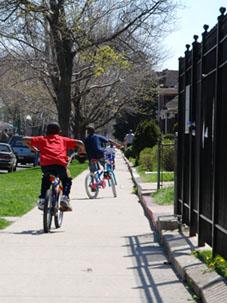 Boys ride their bikes in Auburn Gresham, one of 16 Chicago neighborhoods targeted for community revitalization as part of the New Communities Program. |
In many communities across the country, local organizations seek to advance the interests of residents and address problems that affect community quality of life. Sometimes they are remarkably successful, as when entrepreneurial leadership capitalizes on local assets and accelerates market-driven changes. Too often, however, local efforts have fallen short of spurring community recovery because they do not have the right combination of information, expertise, time, and money to leverage market and political forces.
The narrative about cities has been dominated for decades by perceptions of urban decay, the flight of people and jobs to the suburbs, and skepticism about the possibilities for progress. But the current reality — evident in our hometown of Chicago and elsewhere — paints a far more interesting and hopeful picture. In the past decade, the population of the nation’s 50 largest cities has grown by nearly 10 percent. This was accompanied by a rise in city incomes that was almost double the national average, and by an increase in housing units, homeownership, and mortgage lending (although this last indicator has turned out to be less positive than it first appeared to be). In the same period, concentrated poverty declined 24 percent and urban crime saw a marked decrease.
Right now, our cities have the best chance in decades to compete for business, workers, and residents and to attempt to alleviate poverty, reduce racial and ethnic disparities, revitalize low-income neighborhoods, promote balanced growth, and ensure that our young people are more prepared for a complex and connected world.
The health and vitality of city neighborhoods is an important predictor of the economic competitiveness of a city and its surrounding region. It also is an important predictor of access to the social and economic opportunity enjoyed by residents.
For these reasons, the MacArthur Foundation is in the midst of a 10-year $150 million investment to improve the quality of life in a mix of neighborhoods in Chicago and increase social and economic opportunity for low-income Chicagoans. This includes supporting the transformation of Chicago’s troubled public housing into new, mixed-income communities, and the large-scale preservation of affordable rental housing. It also involves investments in comprehensive community renewal, in efforts to improve local schools and the juvenile justice system, and to integrate returning ex-offenders into their communities. The idea is to provide long-term support for the many different elements that together can make a neighborhood thrive: schools, housing, health, retail, safety, community cohesion, youth development, and more. Practically speaking, that means working first at scale on the small number of interventions with the greatest potential to stimulate further change.
The Foundation has made a substantial investment in Chicago Local Initiatives Support Corporation (LISC) to operate the New Communities Program (NCP), which calls for the design and implementation of quality-of-life plans to revitalize 16 neighborhoods and reconnect their residents to the region’s economic mainstream. In the process, local energy and expertise will be mobilized and an infrastructure created for other investment and activity.
However, local effort alone, no matter how heroic, is not adequate to the task of addressing the multiple challenges in city neighborhoods when their vitality has been compromised. Thus, the Foundation’s strategy also calls for complementary initiatives in community safety, economic security, and economic development. These are areas where even modest progress is likely to have a large payoff. They are also opportunities to demonstrate large-scale solutions to address problems common to many urban communities.
This approach to comprehensive community revitalization has captured the imagination and interest of practitioners across the country. Hundreds of visitors have come to Chicago to learn about the New Communities Program and the other initiatives. National foundations and government agencies view the program as a framework for investment, and through a new Sustainable Communities Program, the national office of LISC has selected 10 cities where it will support the implementation of comprehensive approaches based on the Chicago model.
As you will read in the pages that follow, five years into the grantmaking program, the Foundation sees encouraging signs of progress. Although it is too early to see cause and effect, against a composite set of indicators, half the NCP neighborhoods have improved while the city as a whole has declined; home prices have increased in all neighborhoods; school achievement is up in about a third of the communities; and graduation rates are up in two-thirds of the neighborhoods. Notably, the rate of business growth was up between 2½ and 3 percent in all of the NCP neighborhoods, against a citywide decrease of about half a percent annually.
This newsletter tells the inspiring stories of community groups that MacArthur supports. But the narrative is more than a series of anecdotes; it is a mosaic of theory put into action that gives us hope that the quest for healthy cities of opportunity for all is within our collective grasp.
Jonathan F. Fanton
President
Vice President's Message: Applying Market Dynamics to Community Change
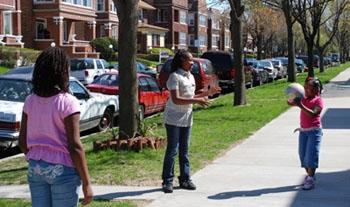 Girls play ball in Auburn Gresham, one of 16 Chicago neighborhoods targeted for revitalization through the New Communities Program. |
With finite resources, a foundation must make hard decisions about the issues and opportunities in which it invests. It must turn its back on organizations, ideas, and strategies, no matter how promising, in favor of those within its chosen areas of interest. Throughout its nearly 30-year history, the MacArthur Foundation has consistently valued and nurtured efforts to strengthen neighborhoods and remake cities. It has done so because of the enduring importance of place in the trajectory of people’s lives and, more recently, because of the role of vital places (communities, cities, and regions) in the nation’s ability to thrive and compete in an increasingly global marketplace. As the timeline in this newsletter reveals, our support has at times led and, at other times, reflected the evolution of the field of community and economic development.
Today, we are in the midst of a 10-year effort to create and sustain economically diverse neighborhoods that offer social and economic opportunity to their residents. This strategy uses an approach that draws on, but goes beyond past efforts in community development. It seeks to leverage change by addressing known barriers to neighborhood recovery; using a market-oriented framework to determine opportunities and choose among alternatives; taking advantage of local assets; infusing local planning with data and expertise, simultaneously using bottom-up and top-down tactics; and emphasizing personal responsibility, individual choice, access to opportunity and social and economic mobility. This orientation to market forces is an important and distinctive feature of the strategy, as is recognition of the strengths and limitations of traditional community development practice.
Another departure for MacArthur was the decision to partner with LISC to help realize our ambitions. Without that partnership, and LISC’s superb on-the-ground skills and fruitful relationships with corporate and government players at all levels, we would not be in the enviable place that we are today — millions of dollars of investment by others in a critical mass of Chicago neighborhoods, tangible projects complete or underway, promising signs of progress and, most important, energized local leadership ready to tackle the challenges that surely persist and will emerge as global, national, and local conditions evolve and change.
New Communities Program: Improving Chicago’s Neighborhoods
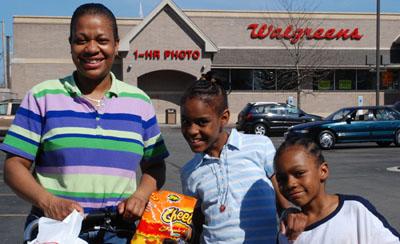 A new Walgreens is the first retail development in 40 years in Chcago's West Haven neighborhood. |
After years of neglect, residents of Chicago’s West Haven neighborhood are relishing some important firsts. A new Walgreens recently opened, becoming the first retail development in 40 years in the community just west of downtown. West Haven youth played organized baseball over the summer for the first time in more than 30 years. And in the fall, a new grocery store is expected to break ground not far from where the Henry Horner Homes, a 12-block public housing development that once dominated the landscape, have been razed to make space for a new mixed-income community.
Contributing to the transformation of this historically low-income, African-American community is the New Communities Program (NCP), a collaboration between the MacArthur Foundation and the Chicago office of the Local Initiatives Support Corporation (LISC). West Haven is among 16 neighborhoods selected to participate in the 10-year community development program that targets parts of the city challenged by poverty, neglect and disinvestment.
“Others, like me, have been through this before — have made big announcements [about efforts to turn around urban neighborhoods] and they fizzle out or implode,” observes Andrew Mooney, senior program director of LISC in Chicago, which administers the program.
But in the two years since community leaders presented plans to Mayor Richard M. Daley and Foundation President Jonathan F. Fanton at a meeting in downtown Chicago, neighborhoods from Humboldt Park on the city’s West Side to Auburn Gresham on the South Side have courted new investors and attracted new services.
“[NCP] has led to very positive outcomes in nearly all the neighborhoods in which it is operating,” says Mooney.
The NCP approach is defined by a community-based lead agency serving as a local intermediary; long-term commitment and flexible funding; technical support and seed money from LISC; and broad-based planning leading to a five-year quality-of-life plan for each community.
The community plans link physical elements, such as housing and retail developments, with programs and services, including schools, parks, health care, child care, community safety, youth development, social services, and economic opportunities.
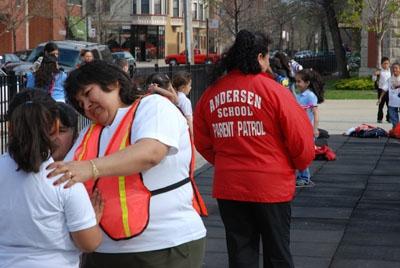 Humboldt Park parents help make their children's schools safe as part of an effort funded through the New Communities Program. |
The New Communities Program’s comprehensive approach also has garnered the attention of others. MacArthur’s first investment of $21 million enabled LISC and its community partners to attract $225 million of additional investment in the 16 neighborhoods. Based on LISC’s projections, MacArthur anticipates that its second investment of $26 million, made in March 2006 in support of full implementation of the community plans, will yield $500 million in additional public and private investment in targeted Chicago neighborhoods.
“Our partnership with LISC seeks to leverage change by addressing known barriers to neighborhood recovery,” said Julia Stasch, MacArthur’s vice president for U.S. grantmaking. “The idea is to use a market-oriented framework to determine opportunities and choose among alternatives, taking advantage of local assets and infusing local planning with data and expertise.”
The Foundation’s commitment to improving the quality of life for residents in the 16 neighborhoods also extends to efforts that affect the decisions of homeowners, businesses, and others. These include programs to increase community safety, economic security, and commercial development. The underlying assumption is that successful individuals and strong communities — those that encourage personal growth, provide economic opportunity, and promote participation in civic life — are interrelated. The purpose is to achieve measurable improvements in neighborhoods on indicators such as income diversity, property values, health outcomes, crime rates, educational achievement, and business starts
and retention.
More than half of Chicago’s low-income communities, typically those where the poverty rate exceeds the city average of 31 percent, were chosen for the New Communities Program. But some NCP neighborhoods are addressing poverty and gentrification at the same time, with the added challenges of preserving the community for current residents in the face of change.
In some neighborhoods, efforts were well underway when NCP started: five communities were the focus of earlier MacArthur Foundation grantmaking, and three had been targeted by LISC/Chicago for an earlier pilot program. In other neighborhoods, NCP sparked the development activity. Overall, the mix of participating neighborhoods is representative not only of Chicago, but also of the types of problems facing urban communities across the nation.
When task forces of residents, business owners, police officers, school principals and others in each community began to meet in 2003 to gather information and identify concerns, the goal was to create a five-year plan for tangible change. Participants were encouraged to move beyond a traditional approach to development, which focuses on housing and other real estate development, to one that encompassed schools, employment, health care, public safety, recreation, open space, transportation, and more.
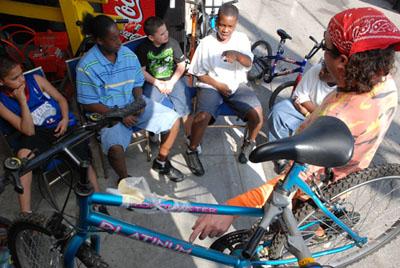 BickerBikes program provides free bikes to kids in Humboldt Park and teaches them how to maintain them. |
In total, more than 4,000 people were involved in the planning process, serving on task forces or participating in community-wide meetings. LISC provided guidance for the planning process with support from professional facilitators, urban planners and researchers. “Scribes,” or journalists, documented the discussions and drafted versions of the plans for group review and agreement. Decision-making was based on hard data about neighborhood conditions and detailed information about projects already in progress, including those planned by private developers and the City of Chicago. This attention to existing efforts paved the way for the Mayor and city officials to support the results of the planning process.
At the same time, communities instituted “early action” projects that were achievable in six to nine months and were intended to build momentum and gain credibility for NCP — to show that progress was possible. Lead agencies competed for grants to fund these projects.
“One of the things the early action projects did was to make NCP real for [community] partners. The ‘doing while planning’ notion was a good one,” says Joy Aruguete, executive director of the Bickerdike Redevelopment Corp. Bickerdike is the lead agency in Humboldt Park, home to an equal number of black and Latino residents. Bickerdike’s early action projects included cultural activities, such as painting a mural on a neighborhood building; BickerBikes, which provides free bicycles to neighborhood youth and teaches them how to maintain and repair them; and the Chicago Commons Youth Investment Club, an after-school program to improve young people’s math and critical thinking skills.
NCP already has generated $1.7 million of investment in Humboldt Park, attracting about $2.40 for every $1 from LISC. Working to stem gentrification on the community’s east side and attack blight on the west side, Humboldt Park is “staking a claim for working class residents,” according to its quality-of-life plan. Projects underway include a 57-unit residential and retail development on Division Street, the main commercial strip; a community-based land trust to purchase lots for affordable housing; and a Center for Working Families, which helps low-income families achieve financial stability and build wealth through services such as financial counseling, free tax preparation, and access to fairly-priced financial products..
In addition to attracting new resources, Humboldt Park groups have pulled together to achieve common goals, despite what originally appeared to be competing interests.
“There was a perception that if someone wins, someone else loses, and I think it’s been our attempt to create a win-win environment for the New Communities Program in Humboldt Park,” Aruguete says.
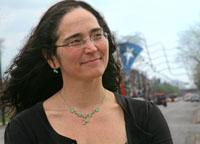 Joy Aruguete of Bikderdike. |
Bickerdike has helped move the community forward by capitalizing on its strengths and resources, sharing decision making, encouraging other groups to take the lead on projects, and giving credit where it is due. And it has infused all that it does with a commitment to embracing racial and ethnic differences in the rapidly changing community. “I don’t think you build [positive] race relations through one day of programming. You have to weave it into everything you do,” comments Aruguete.
Like Humboldt Park, Chicago’s West Haven neighborhood is confronting racial issues. But in West Haven, also known as the Near West Side, low- and moderate-income African-American residents are being joined by middle- and upper-income newcomers who are more racially diverse. “The long-term challenge is to get people on the same page in terms of how a community should function as a community,” according to Earnest Gates, president of the Central West Community Organization and a founder of the Near West Side Community Development Corporation. “There are varying interests, based on economics, politics, and race. Getting people in one accord is a challenge.”
The change in demographics is a result of the Chicago Housing Authority’s Plan for Transformation, a $1.6 billion initiative to replace thousands of public housing units, such as the Henry Horner Homes, with new mixed-income communities.
As the NCP lead agency in West Haven, Near West has led the effort to create a viable, mixed-income community. Gates says the NCP planning process helped to create a forum where old and new residents could work together.
“When you talk about what the community needs, everyone is talking about the same thing: open space, clean streets, city services, economic development. The planning process proved that folks in public housing and folks with means can plot a process to take the community forward for the benefit of everyone,” Gates says.
In addition to the new Walgreens, a bank, market-rate condominium and townhouse developments, and affordable housing have replaced vacant lots.
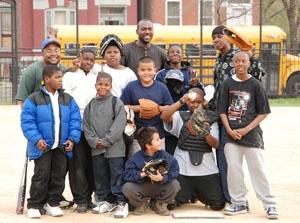 West Haven youth played organized baseball during the summer of 2007 for the first time in 30 years. |
“Creating the atmosphere and a market where people want to come in and develop was a major achievement, and it happened without displacing one soul,” Gates says.
The improvements that the community has fought so hard to achieve are presenting their own challenges. Near West is now competing with market-rate developers for ever-scarcer and more expensive land.
On the city’s South Side, the New Communities Program is helping to stabilize Auburn Gresham, an African-American community of brick bungalows and sturdy two-flats, by working to build new affordable housing, maintaining the existing housing stock, and strengthening the commercial districts.
Auburn Gresham considers itself one of “Chicago’s best kept secrets.” But while the neighborhood has maintained a strong housing market, disinvestment had weakened commercial areas and the population had declined since the 1990s. Already on the rebound prior to its selection as an NCP community, Auburn Gresham has seen physical improvements and more subtle changes as a result of its participation in the program, according to Carlos Nelson, executive director of the Greater Auburn-Gresham Development Corporation (GADC).
Nelson points to existing and upcoming construction projects: a 90-unit affordable housing development anchored by a city office; a 7,000-square-foot training center and adjoining restaurant; an abandoned building converted to a “green” facility of housing, offices, and meeting space.
At the same time, “We are beginning to change the culture. We have rallied people around the positive aspects of the community. Growing up here, we didn’t refer to the neighborhood as Auburn Gresham. If you asked me where I lived, I would say 79th and Halsted,” says Nelson, referring to an intersection near his home. “Because of NCP and how substantial this organization (GADC) has become, we’ve now branded ourselves as Auburn Gresham.”
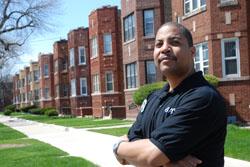 Carlos Nelson of the Greater Auburn-Gresham Development Corporation. |
Like Nelson, most of the participants in the New Communities Program are pleased with its progress thus far and, without minimizing the challenges that lie ahead, are optimistic about the future.
Likewise, NCP is garnering attention across the country. Community development practitioners, funders, and elected officials have come to Chicago to see how the program works. The national office of LISC has selected sites throughout the U.S., about one-third of the cities in which it operates, to participate in a program modeled on NCP. Called the Sustainable Communities Program, its national rollout will go a long way toward establishing the NCP approach as the emerging standard in the community development field. MacArthur has invested $4 million in its initial design and operation.
“The biggest contribution of the New Communities Program,” says Mooney, “is that it has reinvigorated the field of community development in Chicago, and is now leading to a similar impact at the national level.”
The NCP Approach At-a-Glance
- A primary long-term investor (MacArthur Foundation) or group of investors provides flexible funding for staffing, program grants and a robust communications effort.
- A hands-on central intermediary (LISC) channels resources and expertise to neighborhoods, coordinates multi-neighborhood efforts, and leverages additional public and private investment.
- A community organization or development corporation (lead agency) in each neighborhood serves as local intermediary, developing partnerships and spearheading change.
- Broad-based planning processes, organized by the lead agency, bring together community members with urban planners and other experts to develop market-driven plans.
- Comprehensive quality-of-life plans, including economic development, housing, jobs, services, public safety, and more provide a blueprint for action and investment.
- Deep, long-term relationships are nurtured among lead-agency staff, LISC program officers, local and citywide organizations, providers of support services, and especially public agencies — all sharing responsibility for implementation.
- Clear, sophisticated communications.
- Clear goals and benchmarks enable progress to be measured and mid-course corrections to be made. Careful documentation and an independent evaluation create credibility.
- Others see opportunities to participate and promote urban revitalization, thus leveraging the program’s scale and infrastructure.
Supporting Neighborhood Organizations: Grants to Community Groups
LISC uses MacArthur Foundation funds to make grants to organizations in the 16 NCP neighborhoods to help realize the quality-of-life plans developed by each community. The following are examples of grants awarded by LISC since the launch of the program.
Bickerdike Redevelopment Corporation, Humboldt Park
$12,200 for the development of a new comprehensive condominium homeownership manual.
Garfield Park Conservatory Alliance, East Garfield Park
$18,000 for ROADMAP — a Madison Street Commercial Corridor initiative.
Greater Auburn Gresham Development Corporation, Auburn Gresham
$12,000 for the 79th Street Renaissance Festival.
Logan Square Neighborhood Association, Logan Square
$11,100 for a sex education program at local middle schools./p>
Celestial Ministries, North Lawndale
$10,000 for a music education program serving children of incarcerated parents.
The Resurrection Project, Pilsen
$15,000 for the expansion of the Resurrection Basketball League to include a second community and
to add an art component.
Growing Home, Inc., Englewood
$40,000 to establish a job training and job creation initiative focused on urban agriculture.
Inner-City Muslim Action Network, Chicago Lawn
$32,175 for project initiation loan to bridge the organization’s capital campaign. Funds will cover costs of a strategic planner and fundraiser.
Latinos Progresando, Little Village
$25,000 to expand nonprofit legal services in Little Village.
Near West Side Community Development Corporation, Near West Side
$7,500 for a youth development program that uses baseball as a tool to provide tutoring, life skills and leadership training.
Quad Communities Development Corporation, Quad Communities
$5,256 to send staff to the International Council of Shopping Centers Conference in order to market the Cottage Grove retail corridor.
South Chicago Art Center, South Chicago
$10,000 for a consultant to help the organization develop a business plan.
South Side Community Federal Credit Union, Washington Park
$35,000 in support of a pilot checking account program for the unbanked in Washington Park.
Measuring for Success: Evaluating NCP
To determine whether the New Communities Program (NCP) is changing Chicago neighborhoods for the better, MacArthur is supporting one of the most extensive and rigorous evaluations of a community revitalization initiative ever attempted.
The effort is being led by MDRC, a nonprofit research firm that has pioneered the use of randomized controlled trials in the evaluation of social programs. Partnering with MDRC in the research are the University of Chicago’s Chapin Hall Center for Children and the Metro Chicago Information Center.
The evaluation will examine and compare long-term trends in quality of life indicators including measures of income and racial diversity, residential and commercial vitality, and neighborhood safety and appeal. The evaluation team will explore how core principles of NCP were put into practice; what it took on the part of the main organizations to do so; and how, and to the extent possible why NCP communities have begun to change.
The MDRC research team will also compare indicators in the 16 NCP areas with those in other Chicago communities. With so many communities and partners involved, the research has a much greater opportunity than most to compare and contrast attempts at change across diverse neighborhoods and among different organizations, and to understand the possible power of a spillover effect. Although these methods will not prove cause and effect, they do produce a kind of rigorous analysis that leads to confidence in the results.
Evaluators have the unprecedented advantage of access to data about Chicago neighborhoods, which was compiled with funding from MacArthur, that goes back 50 years. The Metro Chicago Information Center, a nonprofit research organization that focuses on social change and quality of life issues, has one of the nation’s most comprehensive databases on neighborhood indicators.
“Building a database the size and scope of MCIC’s would have been prohibitively expensive,” explains George Galster, an urban affairs expert from Wayne State University who is advising MDRC. “It provides us with invaluable insight.”
The database can help provide a baseline for understanding NCP and includes detailed measures about employment, crime, and infant mortality rates, household income, property values, and school completion, among other information.
While the exact nature of outcomes will likely vary among neighborhoods, the MacArthur Foundation expects to see quantifiable improvements in each NCP area — positive trends on a number of important indicators of neighborhood change. Areas for improvement include employment and earnings of residents; small business starts, retention, and expansions; public and private investment; and general increases in citizen participation in community life, such as in community policing and violence reduction campaigns, and efforts to improve local schools. Improvements on these indicators are expected to ignite additional investor interest, motivating residents, businesses, and others to invest in the community, triggering momentum for further change.
As data is gathered and analyzed, it will be shared with the NCP neighborhoods and distributed to other practitioners and policymakers across the country. It also will contribute to a future effort to look across communities in the U.S. including those participating in the LISC Sustainable Communities Project, which will adapt the NCP approach to selected cities across the country.
Community Mapping Comes Full Circle
The Greater Southwest Development Corporation (GSDC) wanted to know more about the brick bungalows that line the streets of Chicago Lawn, one of the 16 neighborhoods participating in the New Communities Program (NCP)(see article, page 3). Bungalow owners are eligible for public funds to maintain and renovate their homes, and as part of its effort to keep housing affordable for residents, the group decided to survey the neighborhood to see where the bungalows are and what condition they are in.
Until recently, the project would require recording the data manually and then re-entering it into a database. However, Greater Southwest was able to take advantage of new technology and technical support available through Full Circle, a mapping and planning project run by the Chicago Metropolitan Agency for Planning (CMAP). Using “smart phones,” handheld wireless devices about the size of an iPod, Greater Southwest staffers trained by CMAP surveyed four census tracts in Chicago Lawn, transmitting information directly to the agency’s data repository of housing and community development data. CMAP helped GSDC decide what data to collect, supervised the data entry, and assisted Greater Southwest in analyzing it.
The CMAP repository, www.chicagoareahousing.org, includes data on 1.8 million properties in the Chicago region. The agency, supported by a three-year grant from the MacArthur Foundation, has made Full Circle available to the NCP communities, along with others in northeastern Illinois. Each NCP community has created a quality-of-life plan that guides its Full Circle projects. The data is useful in carrying out the plans, monitoring progress, and making adjustments based on new information.
NCP lead agencies are using the wireless data-gathering and mapping technologies for a variety of purposes, including attracting businesses, stabilizing homeownership rates, and drawing up zoning recommendations. Users are able to access and map public information from the city, county, and federal governments about individual properties, including use and age of structures, property values, historical significance, and environmental issues. They can also update or add information and link it to the existing data, contributing valuable information to the regional database.
In the communities of Douglas, Grand Boulevard, North Kenwood, and Oakland, clustered south of downtown near Lake Michigan, the Quad Communities Development Corporation, an NCP lead agency, used the Full Circle data collection system to attract new businesses to the area. Quad Communities recruited 10 students from the nearby University of Chicago to determine what types of businesses are located in the neighborhoods, how large the buildings are, what condition they are in, where there are vacant commercial sites, and more. CMAP staff worked closely with Quad Communities to identify the precise data the community needed, and to train the students to collect it.
|
CMAP has developed hand-held devices called "smart phones," which aid in th ecollection of community data. |
Smart phones in hand, the students walked a mile and a half along Cottage Grove Avenue, a main business artery, plus a one-mile radius on major intersecting streets, collecting extensive information about the commercial corridors. As a result of the project, local planners learned that the business vacancy rate was a high 11 percent, and that only about half the listings in the local phone directory were accurate.
The organization has used the data to produce the area’s first business directory and to identify sites that might be attractive to developers and retailers.
In addition, data on the location of trash cans and litter were used to generate maps showing the need to improve the appearance of the business district. The maps helped to secure city funding for a $150,000 beautification effort that employs ex-offenders and others to collect trash, pick up litter, and remove graffiti.
In Chicago Lawn, the Full Circle data also translated into dollars that are benefiting the community. At the same time that they were collecting data about bungalows, the Greater Southwest Development Corporation staffers alerted residents that they could certify their bungalows through the Historic Chicago Bungalow Initiative, making them eligible for up to $8,300 in home improvement grants and energy-efficient appliance vouchers.
In addition, while conducting the survey and during subsequent informational meetings, GSDC educated residents about the Southwest Home Equity Assurance Program, a state program that offers area homeowners up to $10,000 in loans at 0 percent interest, and about property tax exemptions available to Cook County residential homeowners. “We got more out of the mapping project than we expected,” notes Donna Stites, the New Communities Program director at GSDC.
The group mapped 2,300 properties and, of those, 1,400 were bungalows. As a result of the bungalow-mapping project, 210 homeowners certified their properties. In all, the effort generated more than $340,000 in home improvement resources for neighborhood residents, according to Stites.
“Talk about effective targeting of public investment in community development,” says CMAP’s information architect Greg Sanders. “You can’t do much better than that.”
Improving Chicago Neighborhoods: Grants List
In addition to support to LISC for the New Communities Program, MacArthur makes grants to organizations working across multiple neighborhoods on economic security, community safety, economic development, schools and housing. The following is an illustrative list of grants.
After School Matters, Chicago, IL
$600,000 for youth development programs in 16 neighborhoods in Chicago.
Center for Economic Progress, Chicago, IL
Two grants totaling $1,750,000 to deliver tax counseling, financial education, and other income-support and asset-building activities for working individuals and families.
Chicago Metropolitan Agency for Planning (formerly the Northeastern Illinois Planning Commission), Chicago, IL
Two grants totaling $960,000 for the Full Circle community mapping and planning project,which makes community and public data accessible to community organizations.
Chicago Project for Violence Prevention, Chicago, IL
$1,200,000 in support of CeaseFire, a public health approach to reducing shootings, homicides, and other violent crimes in Chicago neighborhoods (over four years).
City of Chicago, Department of Police, Chicago, IL
$850,000 to design and test public-access components of a data management system to support community policing.
Community Catalyst, Boston, MA
$1,500,000 for the development and expansion throughout metropolitan Chicago of RealBenefits, an Internet-based eligibility screening software that helps increase individual and family access to income-support programs.
Local Initiatives Support Corporation, Chicago, IL
$75,600 in support of community participation in the design and testing of Internet tools for community policing.
MDRC, New York, NY
$2,500,000 in support of a comprehensive program of evaluation research of the New Communities Program.
Metro Chicago Information Center, Chicago, IL
$900,000 to track indicators of community well-being in Chicago neighborhoods, assemble and analyze data and trends, and increase the use of data in community planning and development.
Neighborhood Housing Services of Chicago, Chicago, IL
$1,750,000 in support of programs that promote residential stability and homeownership in Chicago neighborhoods.
Project Match, Chicago, IL
$1,300,000 to assist community programs that aim to improve employment outcomes in low-income neighborhoods in Chicago.
Safer Foundation, Chicago, IL
$5,000,000 in support of SaferReturn, a prisoner reentry demonstration in East Garfield Park neighborhood.
ULI Foundation, Washington, D.C.
Three grants totaling $829,000 in support of the development of The Preservation Compact, an effort to accelerate efforts to preserve affordable rental housing in the Chicago region.
University of Chicago, Center for Urban School Improvement, Chicago, IL
$2,000,000 in support of efforts to improve quality of education in the Chicago public schools.
University of Illinois at Chicago, Department of Criminal Justice, Chicago, IL
$97,000 to document and assess community participation in the design and use of web-enabled tools to improve citizen/police relations and neighborhood safety.
Bridging the Information Gap in Urban Markets
 The Cannery, a proposed retail development on Chicago's South Side, will be designed as a "neighborhub" that appeals to ethnic communities underserved by retailers. |
When Chicago real estate developer Quintin E. Primo III decided to build a $500 million commercial and residential development in the South Side community of Bronzeville, he wasn’t looking at the empty lots or the shell of the public housing project across the street from the site. He was looking at potential.
Bronzeville is part of the Cottage Grove Trade Area — an area that boasts potential purchasing power of $191 million per square mile, 23 percent greater than the city average. Forty percent of the area’s households report incomes above the city average. During the past few years, new housing construction and renovation has begun to transform a community of concentrated poverty into an increasingly vital mixed-income neighborhood. Over time, two-thirds of new residents in the area are projected to be middle- and upper-income and, contrary to the stereotypical view of the limited resources in inner-city neighborhoods, current residents spend $450 million a year elsewhere because of a dearth of local retailers.
The area’s untapped potential was revealed by a study commissioned by Quad Communities Development Corporation (QCDC), the lead agency for four neighborhoods participating in the New Communities Program (NCP). It was conducted by LISC MetroEdge, an urban market research firm operated by the national office of Local Initiatives Support Corporation (LISC). MetroEdge was created by Shorebank Corporation in 1998 with additional investments from the Ford and MacArthur Foundations to develop new metrics to describe the retail potential of urban communities. In 2006, with support from MacArthur, LISC acquired MetroEdge, and is today providing analyses and products to support on-the-ground commercial projects in localities across the country.
“Local information was critical to convince commercial developers they’d be getting on a moving train,” says Chinwe Onyeagoro, an economic development consultant working with QCDC to revitalize the Cottage Grove Trade Area in Chicago. “Our challenge was to help people understand local trends and how positive they were.”
Research conducted by LISC MetroEdge helps to demonstrate to investors and developers that there is money to be made in urban communities. Unlike traditional market research, it takes into account factors such as population density and income diversity to determine how much spending power communities actually have. Conventional data, such as employment statistics, may not accurately reflect what’s happening in mixed-income economies, where a lot of income is earned from part-time jobs, or in mom-and-pop businesses that don’t have the same reporting requirements as larger companies. Census and other government data may fail to keep pace with fast-changing inner-city neighborhoods. The census also tends to undercount mixed-income communities, where many people move households and change jobs frequently.
 New condos under construction on Chicago's South Side. |
To capture the market potential of inner-city communities, researchers have to drill down to distinct sub-populations — and analyze different characteristics. For example, using per-square-mile measures, which account for population density, makes it easy to see that a wealthy suburb with twice the median household income of an inner-city neighborhood may nonetheless pack only half the spending power.
LISC MetroEdge augments demographic data with local information from government agencies, private research firms, and an in-depth survey of residents’ spending and consumption patterns. The firm analyzes the information using proprietary analytical techniques designed for urban markets.
Primo, chairman and CEO of real estate investment firm Capri Capital Partners, is one of a growing number of investors seeking opportunities in inner cities. He learned about the Bronzeville investment opportunity through his participation in the Partnership for New Communities, a group of civic leaders supporting the transformation of Chicago’s high-rise public housing into mixed-income developments.
Capri Capital rejected the perception that Bronzeville, which spans two communities that are part of the New Communities Program — Douglas and Grand Boulevard, was a bad choice for investment. The LISC MetroEdge report helped convince the firm to enter into a joint venture with Judson Investment Company LLC to build the one-million-square-foot housing and retail development called Metropolis.
“In retail, if you can’t make the case for uniformly high income, you have to make the case for population density and high traffic counts,” explains Capri analyst Careina Williams. “The MetroEdge study gave us those numbers and also buying power analysis. It’s probably the best report that’s been done.”
The first phase of the project will include 330,000 square feet of retail space and 102 condominiums. Twenty percent of the homes will be reserved for low- and moderate-income buyers. Metropolis was designed by architecture firm Skidmore, Owings & Merrill LLP, best known for two soaring Chicago landmarks: the Sears Tower and the John Hancock building.
“We believed that if designed properly and built properly, we would create a project that would be welcomed by the community and would translate into high dollar-per-square-foot rents for us and high sales for the retailers,” Primo told WSJ.com. “It makes great economic sense for hard-nosed, cold-hearted, socially-disinterested business organizations to pursue this market.”
Ben S. Benanke, Chairman of the Federal Reserve Board, agrees. In a 2006 speech to an international audience via satellite, Bernanke cited the case of “…a national home-improvement retailer [that] used MetroEdge data as the basis for its decision to establish a store in inner-city Chicago, even though the retailer’s own site-selection model presented discouraging indications of profit potential for that neighborhood. With access to new market data, the company could justify its investment in the community, and sales performance was triple what was expected within the first six months of operation.”
“Free markets can be a powerful source of economic development, but markets work less effectively when information about potential opportunities is absent or costly for private actors to obtain,” said the Chairman. LISC’s MetroEdge is helping the market work for inner-city neighborhoods, in Chicago and across the country.
Community Development Timeline
1981
MacArthur awards $1 million grant to establish the Local Initiatives Support Corporation, which has grown to become one the nation’s most productive networks of community development organizations.
1983
MacArthur begins nearly 25 years of support for community development financial institutions. Since 1983, more than $235 million has been invested in CDFIs across the nation to provide more than $3 billion in financing for community development purposes across the nation.
1991
MacArthur helps establish the National Community Development Initiative (today called Living Cities), a national consortium of foundations, financial institutions, and federal agencies designed to spur economic development in 23 cities across the country.
1992
MacArthur launches the Project on Human Development in Chicago Neighborhoods (PHDCN), an eight-year study of human development within the context of families and communities. MacArthur also initiates an eight-year, $11 million Community Development Capacity Building Program to support the organizational development of Chicago organizations and advance the field of community development.
1996
With LISC Chicago, MacArthur co-sponsors the design and implementation of the Futures Committee, which led to a rethinking of the field of community development in Chicago in the late 1990s.
1999
MacArthur commits $50 million to support Chicago’s ambitious $1.6 billion Plan for Transformation of public housing, including the replacement of obsolete high rise developments with new mixed-income neighborhoods.
2002
MacArthur awards two grants totaling $17.5 million to LISC to operate the New Communities Program in 16 Chicago neighborhoods. The new program is based on the Futures Committee findings, pilot efforts in three neighborhoods, along with the results of the PHDCN and other research. Fourteen lead agencies undertake urban planning processes, produce strategic plans for improving the quality of life in the 16 communities, and begin to implement projects and activities.
2005
Mayor of Chicago, Richard M. Daley, embraces the plans for NCP neighborhoods, directs staff and other resources to support the plans, and uses the neighborhood infrastructure of NCP to develop and launch new programs. To document and share the lessons of NCP, MacArthur funds Metro Chicago Information Center to track trends in indicators of community change, and MDRC to design and begin work on an impact evaluation of the program.
2006
MacArthur awards $3 million for Centers for Working Families in 13 neighborhoods, programs that integrate workforce development, financial services, and work supports; provide individualized financial planning and management assistance to low-wage workers; and deliver products and services through trusted community organizations.
2007
Encouraged by promising early results, MacArthur renews support for the New Communities Program, awarding $26 million for its operation through 2011, and makes a grant of $4 million for adaptation of the NCP approach across the country through the Sustainable Communities Program of National LISC.
Centers for Working Families: Building Financial Stability in Low-Income Neighborhoods
 Families throughout NCP neighborhoods are eager to learn abour financial and other services available to them. |
When Erin Green was laid off last January, the Centers for Working Families (CWF) helped her land a new job in just three days. The 30-year-old divorced mother of two, who was referred to the center by a friend, now works in the office of a clinical psychologist at Chicago’s Michael Reese Hospital.
The employment and financial services centers are part of the New Communities Program (NCP), which recognizes that investing in neglected communities also means investing in their residents. The 12 centers help residents throughout the city climb the economic ladder so they can become a stabilizing force in their communities.
Whether it’s looking for a job, like Green, or trying to repair damaged credit, the centers offer “one-stop” access to products and services tailored to low-income families. The services address their economic realities — and their aspirations.
“We help people get good jobs, get out of debt, and effectively manage the assets they have,” says Christopher Tan of the Local Initiatives Support Corporation (LISC), which operates the centers. The group expects to add another center in 2008.
“Because the long-term vitality of these neighborhoods and that of their residents is inextricably linked,” says Tan, “we’re in the business of developing both families and the communities they call home.”
CWF sites in Chicago span the city geographically — from Uptown to Chicago Lawn, West Garfield Park to Southeast Chicago — and serve a remarkably diverse mix of races and ethnicities. The centers are strategically situated in communities with large populations of working poor families, in proximity to the residents of all NCP neighborhoods.
Median annual household incomes in these communities range from $10,800 to $39,000. While some appear to be higher-income neighborhoods — poised on the edge of gentrification — they include significant populations of poor families. For example, in Logan Square, where real estate values are skyrocketing, the median annual family income approaches the citywide average of $40,720. But 17 percent of families still live at or below the federal poverty level, which is calculated at $20,000 per year for a family of four.
CWF staff work with any Chicagoan who wants assistance, including many who do not qualify for traditional employment programs because they are not welfare recipients, dislocated workers, or from another category eligible for targeted federal funds — or they lack required reading and writing skills. Each site offers employment services, financial counseling, free tax preparation assistance, and access to well-priced financial products including low-cost loans, flexible checking accounts and first-time homebuyer financing.
Taking a cue from the medical profession, counselors urge clients to never leave without making a next appointment. “They advise people when they should come back,” says Ricki Lowitz, the LISC senior program officer who designed the Chicago effort. “They tell jobseekers, ‘Come see me when you get a job, and we’ll talk about your credit report.’”
The centers also help clients determine their eligibility for public programs such as Food Stamps, Medicaid, and the Illinois Child Care Assistance Program — and for the Earned Income Tax Credit, which can boost a family’s income by as much as 40 percent.
CWF services are provided through a network of citywide providers and trusted community-based organizations that deliver their combined expertise at neighborhood sites. Chicago-based Center for Economic Progress, now the nation’s largest and most effective nonprofit provider of tax counseling and preparation services, puts its 1,000 volunteer preparers and professional financial counselors to work at CWFs. In the 2007 tax return season alone, nearly 7,000 tax returns were prepared at Centers for Working Families and almost $11 million was generated for clients through the Earned Income Tax Credit.
Project Match, a nationally recognized leader in helping those with the greatest obstacles to employment, helps develop the capacity for CWFs to assist very low-skilled and low-wage workers. It also monitors performance at each site, analyzes monthly data across sites, and examines the data for patterns in the financial circumstances and practices of clients that can point the way to policy solutions.
And Community Catalyst, a pioneer in developing software for determining eligibility for public benefits, trains CWF counselors to use the RealBenefits software program to assess eligibility and, where possible, to automatically enroll clients in programs such as Food Stamps, Medicaid, and Medicare that increase economic stability and then calculate potential return from the Earned Income Tax Credit.
“This combination of citywide and local organizations allows us to achieve scale and serves as a powerful tool for systemic change,” says Tan. “We’ve got all the best players involved.”
Developed by the Annie E. Casey Foundation, the Centers for Working Families model is being piloted in several cities including Albuquerque, Atlanta, Baltimore, and New York. In Chicago, MacArthur is taking the approach to scale, providing $3 million to fund CWF operations at 13 sites, while also underwriting the contributions of Project Match, the Center for Economic Progress, and Community Catalyst to the effort.
The Chicago centers address all aspects of a family’s finances — employment, debt and money management — as a single, integrated system. “We focus on putting wages within the broader context of longer-term financial goals,” says Deidra Thomas, a financial coach who joined the Centers for Working Families after 18 years in the banking industry.
All of the centers’ financial counselors bring extensive “real world” experience from the business sector and include lawyers, loan officers and other finance professionals. They help clients pursue personal goals, such as owning a home or sending children to college, as the motivator for resolving immediate issues such as repairing credit.
With a credit score of 542, monthly net income of $166.40, and net worth of -$4,455, the average CWF client can benefit from the variety of services offered. Tan notes that credit scores are steadily increasing among CWF clients, allowing them greater access to mainstream financial services and reducing their reliance on predatory lenders. Along the way, clients are also improving their financial habits and acumen. “We want to move people from a state of chronic debt to economic well-being,” says Tan. “It is along this continuum that we will evaluate our success.”



